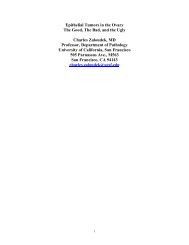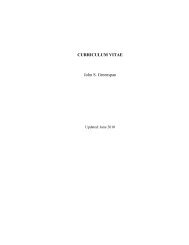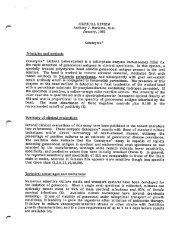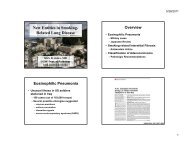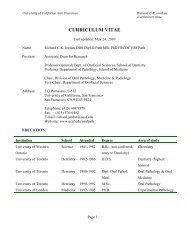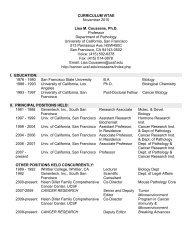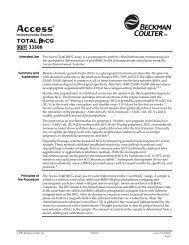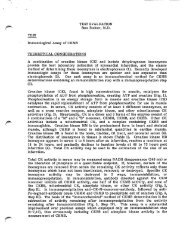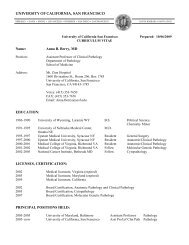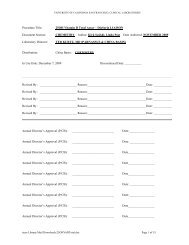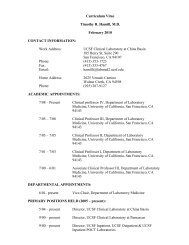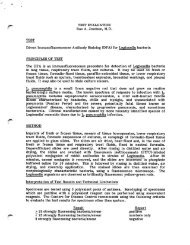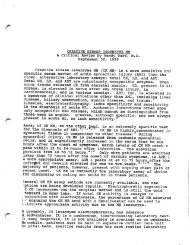Human Growth Hormone
Human Growth Hormone
Human Growth Hormone
You also want an ePaper? Increase the reach of your titles
YUMPU automatically turns print PDFs into web optimized ePapers that Google loves.
Summary and Explanation<br />
<strong>Human</strong> <strong>Growth</strong> <strong>Hormone</strong><br />
(Recombinant 98/574)<br />
DPC Immulite 2000<br />
<strong>Human</strong> growth hormone (hGH, somatotropin) is a polypeptide originating in the anterior pituitary. It is 191<br />
amino acids in length and has a molecular mass of approximately 22,000 daltons. Its metabolic effects<br />
are primarily anabolic. It promotes protein conservation and engages a wide range of mechanisms for<br />
protein synthesis. It also enhances glucose transport and facilitates the buildup of glycogen stores.<br />
Another family of peptide hormones, the somatomedins, mediates its cascade of growth-promoting<br />
actions. 1<br />
Measurement of hGH is primarily of interest in the diagnosis and treatment of various forms of<br />
inappropriate growth hormone secretion. Clinical disorders of hyposecretion include dwarfism and<br />
unattained growth potential. Hypersecretion is associated with gigantism and acromegaly.<br />
Caution must be exercised in the clinical interpretation of growth hormone levels. These vary throughout<br />
the day, making it difficult to define a reference range or to judge an individual's status based on single<br />
determinations. Many factors are known to influence the rate of growth hormone secretion, including<br />
periods of sleep and wakefulness, exercise, stress, hypoglycemia, estrogens, corticosteroids, L-dopa,<br />
and others. 1 Because of its similarity to prolactin and placental lactogen, earlier growth hormone<br />
immunoassays were often plagued with falsely high values in pregnant and lactating women.<br />
Because not all acromegalic individuals have elevated baseline levels, suppression tests based on<br />
glucose loading are of value in this context. In spite of the induced hyperglycemia, there is rarely a<br />
decrease from baseline levels in acromegaly. 2<br />
<strong>Growth</strong> hormone-deficient individuals have fasting/resting levels similar to those found in healthy<br />
individuals. Various challenge tests have therefore been devised to differentiate these groups. Thus, with<br />
the onset of deep sleep or after 15 to 20 minutes of vigorous exercise, growth hormone levels normally<br />
show a rise. Other tests of growth hormone responsiveness are based on the administration of L-dopa,<br />
arginine and insulin. Propanolol or estrogen are sometimes given in conjunction with the primary stimulus<br />
to accentuate the response. 4,5<br />
A small number of cases of dwarfism have been documented in which both the basal level and the<br />
response to challenge testing were normal. Such cases may involve tissue insensitivity to either growth<br />
hormone or the somatomedins, or the presence of antibodies or immunoreactive but biologically inactive<br />
growth hormone. 4<br />
Principle of the Procedure<br />
IMMULITE 2000 <strong>Growth</strong> <strong>Hormone</strong> is a solid-phase, two-site chemiluminescent immunometric assay.<br />
Incubation Cycles: 1 × 30 minutes.<br />
UCSF Clin Labs Chemistry 1 of 6 Proc/DPC Immulite/Immulite 2000 GRH_2 nd IS_June 6, 2011
Specimen Collection<br />
Collect the blood sample in a tube containing no additives. Centrifuge the sample and separate the<br />
serum. Centrifuging serum samples before a complete clot forms may result in the presence of fibrin. To<br />
prevent erroneous results due to the presence of fibrin, ensure that complete clot formation has taken<br />
place prior to centrifugation of samples. Some samples, particularly those from patients receiving<br />
anticoagulant therapy, may require increased clotting time. Avoid grossly hemolyzed, grossly lipemic and<br />
grossly icteric samples.<br />
Volume Required: 25 µL serum (excluding dead space)<br />
Storage: Stable for 2 months at -20°C. Avoid repeated thawing and freezing.<br />
Warnings and Precautions<br />
For in vitro diagnostic use.<br />
Reagents: Store at 2–8°C. Follow universal precautions, and handle all components as if capable of<br />
transmitting infectious agents. Source materials derived from human blood were tested and found<br />
nonreactive for syphilis; for antibodies to HIV 1 and 2; for hepatitis B surface antigen; and for antibodies<br />
to hepatitis C.<br />
Sodium azide, at concentrations less than 0.1 g/dL, has been added as a preservative. On disposal, flush<br />
with large volumes of water to prevent the buildup of potentially explosive metal azides in lead and copper<br />
plumbing.<br />
Water: Use deionized water.<br />
Materials Required<br />
Chemiluminescent Substrate (L2SUBM): Allow substrate to equilibrate at room temperature (about 20<br />
minutes) prior to opening bottle and dispensing. Avoid contamination and exposure to direct sunlight.<br />
Stable on board after opening at 15-28°C for 30 days, or until expiration date.<br />
Probe Wash (L2KPM): Add ~ 1500 mL of Type 1 deionized water to a clean labeled probe wash<br />
container. Pour the entire contents of one bottle of probe wash into the container and QS to 2000 mL<br />
with Type 1 deionized water. Stable at 15 - 28° until the expiration date.<br />
Probe Cleaning Kit (L2KPM): 100 mL of solution in a brown plastic bottle. Stable at 15-28°C until the<br />
expiration date.<br />
Reaction Tubes (LRXT): (disposable)<br />
NOTE: Components within a kit box are a matched set. Labels on the inside of the box<br />
are needed for the assay.<br />
UCSF Clin Labs Chemistry 2 of 6 Proc/DPC Immulite/Immulite 2000 GRH_2 nd IS_June 6, 2011
GH Bead Pack (L2GRH12)<br />
With barcode. 200 beads, coated with murine monoclonal anti-hGH antibody. Stable at 2–8°C until<br />
expiration date.<br />
L2KGRH2: 1 pack.<br />
GH Reagent Wedge (L2GRHA2)<br />
With barcode. 11.5 mL alkaline phosphatase (bovine calf intestine) conjugated to rabbit polyclonal antihGH<br />
antibody in buffer, with preservative. Stable at 2–8°C until expiration date.<br />
L2KGH2: 1 wedge.<br />
Before use, tear off the top of the label at the perforations, without damaging the barcode. Remove the<br />
foil seal from the top of wedge; snap the sliding cover down into the ramps on the reagent lid.<br />
GH Adjustors (LGHL, LGHH)<br />
Two vials (Low and High) containing lyophilized hGH in a nonhuman serum, with preservative.<br />
Reconstitute each vial with 3.0 mL deionized type 1 water. Mix by gentle swirling or inversion until the<br />
lyophilized material is fully dissolved. Aliquot 0.5 mL into 13x100 false bottom tubes identified with the<br />
appropriate adjustor label (supplied with the kit). Freeze adjustor tubes at -20°C. Stable at -20°C for 6<br />
months. L2KGRH2: 1 set.<br />
BioRad Immunoassay plus Control 1,2 & 3<br />
Each control is reconstituted with 5 mL of Type 1 deionized water. The reconstituted controls are stable<br />
for 7 days when stored at 2 - 8°C.<br />
Multi-Diluent 2 (L2M2Z, L2M2Z4)<br />
NOTE: Dilutions of high hGH samples are only done if requested from a physician.<br />
For the on-board dilution of high samples. One vial of concentrated (ready-to-use), nonhuman<br />
protein/buffer matrix, with preservative. Stable for 30 days at 2-8°C after opening.<br />
L2M2Z: 25 mL. L2M2Z4: 55 mL<br />
NOTE: Aliquot 5 mL of diluent into appropriately labeled 16x100 screw top tubes<br />
provided by Siemens. Labels are supplied by Siemens in the diluent box. Freeze<br />
at -20°C. The frozen aliquots are stable for 6 months at -20°C. Once thawed, the<br />
aliquots are stable for 30 days at 2-8°C.<br />
Assay Procedure<br />
Note that for optimal performance, it is important to perform all routine maintenance procedures as<br />
defined in the IMMULITE 2000 Operator's Manual.<br />
See the IMMULITE 2000 Operator's Manual for: preparation, setup, dilutions, adjustment, assay and<br />
quality control procedures.<br />
Recommended Adjustment Interval: 2 weeks.<br />
Expected Values<br />
Secretion of growth hormone by the pituitary gland is episodic and pulsatile, and transient levels up to 40<br />
ug/L have been observed in healthy subjects. Because serum levels are rather low between pulses in<br />
healthy individuals, immunoassays with sufficient sensitivity are necessary to distinguish patients with<br />
abnormally low values from healthy subjects who have values that happen to fall in the low-normal range.<br />
Thus, basal or random levels of hGH provide little diagnostic information.<br />
UCSF Clin Labs Chemistry 3 of 6 Proc/DPC Immulite/Immulite 2000 GRH_2 nd IS_June 6, 2011
Reference range: Adult Males:
Specificity: The antibody is highly specific for human growth hormone. (See "Specificity" table.)<br />
Specificity<br />
ND: nondetectable<br />
Compound Ug/L Added % Cross Reactivity<br />
FSH 10,000 0.001%<br />
Free Beta HCG 280 ND<br />
HPL 100 0.03%<br />
LH 3,663 0.5%<br />
Prolactin 40,000 ND<br />
TSH 11,125 0.01%<br />
Bilirubin: Presence of conjugated and unconjugated bilirubin in concentrations up to 200 mg/L has no<br />
effect on results, within the precision of the assay.<br />
Hemolysis: Presence of hemoglobin in concentrations up to 512 mg/dL has no effect on results, within<br />
the precision of the assay.<br />
Lipemia: Presence of lipemia in concentrations up to 3,000 mg/dL has no effect on results, within the<br />
precision of the assay.<br />
If there is an interferant (hemolysis, lipemia and icterus), run the sample undiluted and send the<br />
corresponding ETC code:<br />
TUR “Specimen turbid, result may be invalid”<br />
ICTRQ “Specimen icteric, result may be invalid”<br />
HEMRQ “Specimen hemolyzed, result may be invalid”<br />
Reporting Values: Values below 0.1 ug/L are reported as 40.0 ug/L.<br />
AMR (Analytical Measuring<br />
Range)<br />
0.1 ug/L to 40.0 ug/L<br />
Reportable Range 0.1 ug/L to 40.0 ug/L<br />
Dilutions are not performed unless specifically requested by a physician.<br />
UCSF Clin Labs Chemistry 5 of 6 Proc/DPC Immulite/Immulite 2000 GRH_2 nd IS_June 6, 2011
Performing Dilutions (if requested)<br />
References<br />
• Place the Multi-diluent 2 sample diluent labeled with the appropriate barcode into a<br />
sample rack.<br />
• Place the sample(s) needed for dilution into a sample rack<br />
• Press Run .<br />
• After the samples have been scanned, go into the Worklist screen<br />
• Select Next. The first patient accession # should appear.<br />
• Select Test.<br />
• Select test GH and press OK<br />
• Select Dilution<br />
• Select GH<br />
• Select the appropriate dilution factor (e.g. x10).<br />
• At this point, you may do another dilution (e.g. x20) on the same sample by starting again<br />
at “Select Test”.<br />
• Select Accept Patient.<br />
Note: the printed value will be corrected for the dilution factor. You do not need to multiply the<br />
printed value.<br />
1) Whitley RJ, Meikle AW, Watts NB. Endocrinology. Part 2: Protein hormones. In: Burtis CA,<br />
Ashwood ER, editors. Tietz textbook of clinical chemistry. 2nd ed. Philadelphia: Saunders, 1994:<br />
1665-70.<br />
2) Daughaday WM, Cryer PE. <strong>Growth</strong> hormone hypersecretion and acromegaly. Hospital Practice.<br />
no. 8 August 1978;13:75-80.<br />
3) Raite S. The standards for human growth hormone assays. In: Laron Z, Butenandt O, editors.<br />
Evaluation of <strong>Growth</strong> <strong>Hormone</strong> Secretion. Basel: Karger, 1983: 162-9.<br />
4) Van Wyk JJ. Diagnosis of growth hormone deficiency and other causes of growth failure. The<br />
Endocrine Society: Syllabus for the 35th Annual Postgraduate Assembly October 1983: 90-106.<br />
5) Van Wyk JJ, Underwood L. <strong>Growth</strong> hormone, somatomedins and growth failure. Hospital Practice<br />
no. 8 August 1978;13:57-67.<br />
6) Tietz NW, editor. Clinical guide to laboratory tests. 3rd ed. Philadelphia: W.B. Saunders, 1995:<br />
300.<br />
7) Burtis CA, Ashwood ER, editors. Tietz textbook of clinical chemistry. 2 nd ed. Philadelphia: W.B.<br />
Saunders, 1994: 1670.<br />
8) Immulite 2000 hGH reagent insert , 9/8/2010.<br />
UCSF Clin Labs Chemistry 6 of 6 Proc/DPC Immulite/Immulite 2000 GRH_2 nd IS_June 6, 2011



